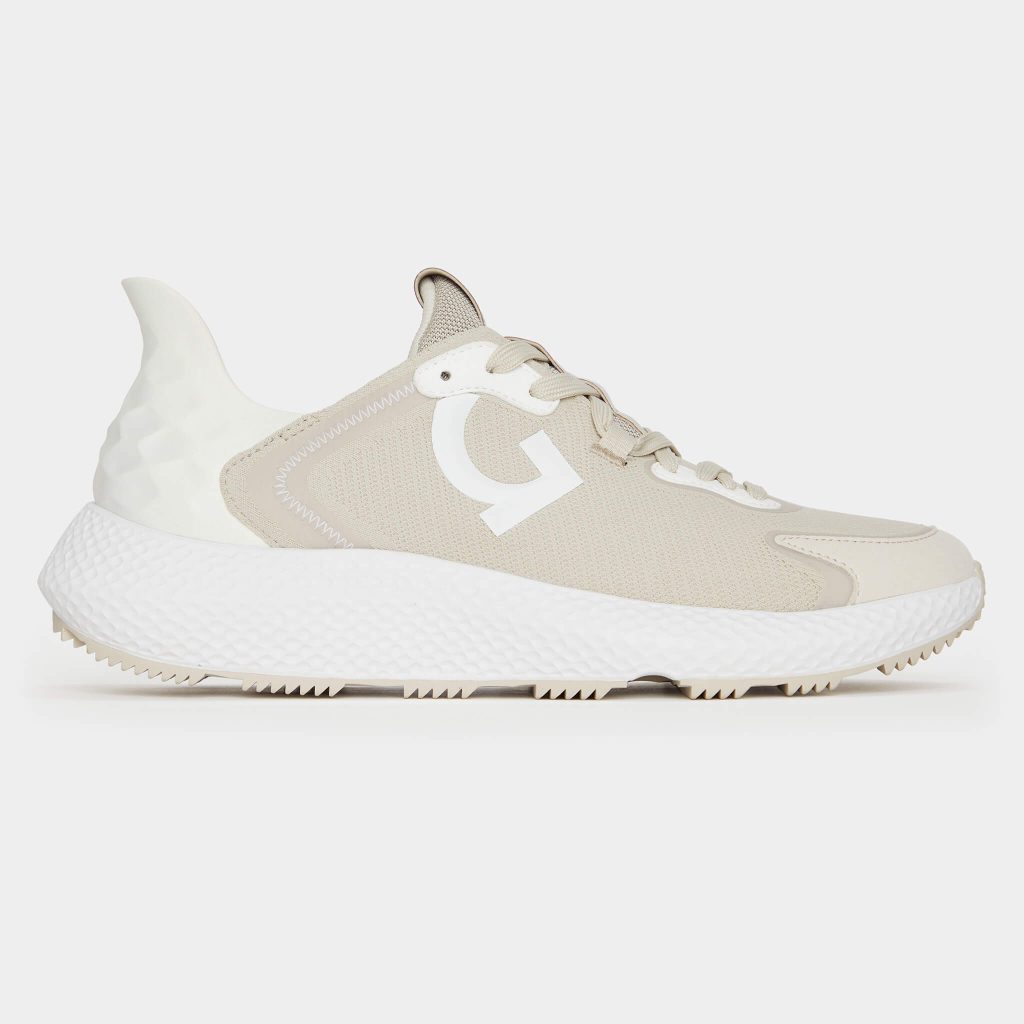The days of Stylo golf shoes for every golfing occasion are long gone. We want a lot more from our golf shoes these days—to the point where many of us have different pairs for different seasons.
For the winter, we seek robust, waterproof, dark-coloured models that laugh at saturated, rough and muddy fairways. In summer, we want something more refined. We want to leave behind the winter shoes that you could probably climb Ben Nevis with and swap them for something you might wear to the pub or go for a run in.
Out goes a search for the ultimate traction; in comes lightweight, chic, uber-comfortable slipper-like models.
We still want grip, durability, versatility, comfort and fit, of course—but also a bit of style.
Here are 10 of the best golf shoes for summer—for men and women—that are perfect for your summer golf. You won’t find a metal spike among them…
1. Ecco S-Three

RRP: £180.00
We love Ecco shoes. Like, really love Ecco shoes. If you play a lot of golf and want to guarantee your feet feel good at the end of 36 holes a day for three days in a row, do not consider anything else but Ecco. Seriously.
Ecco makes the most comfortable shoes on the market, and we don’t think it’s even close.
The S-Three model carries on that legacy with a lightweight, spikeless shoe with plenty of grip and a soft yet durable Gore-Tex upper. Gore-Tex = waterproof, remember?
Its midsole uses Zonal Fluidform technology to create different levels of softness across the foot. The heel offers medium softness for perfect cushioning, too.
2. Under Armour HOVR Tour

RRP: £150.00
These Jordan Spieth-recommended spikeless golf shoe rival spiked models for grip. The soft rubber soles won’t let you down, either.
Under Armour’s HOVR foam, borrowed from the brand’s running trainers, offers loads of cushioning and shock absorption, yet the outsole still has bags of durability and solidity for even the fastest swinger.
It has trademark bold UA styling, and the knitted upper is fully waterproof and easier to clean than you might imagine.
3. Adidas CodeChaos 22

RRP: £140.00
It may look as though it’d be more at home on the basketball court, but this shoe really gets the job done on the golf course.
It is Adidas’ best spikeless golf shoe, helped by a sole that offers TONNES of traction and grip. The Boost cushioning system is a hit, and so is the wide range of colours.
The upper is also totally waterproof, not just showerproof. Oh, and it’s super sustainable, made up of 50% plastic recovered from the ocean.
4. FootJoy Pro SL

RRP: £149.99
There are strong Lee Westwood vibes from these long-time favourites that are still among the best golf shoes around.
They’re comfortable anyway, but then you add in the OrthoLite ‘fitbed’ on top, which moulds to the precise shape of your foot for maximum feel.
The StratoFoam midsole is an upgrade on the original model, and FootJoy’s ChromoSkin leather oozes pedigree. The leather is also waterproof and easily wiped clean.
5. Under Armour Charged Phantom

RRP: £99.99
This might have ‘London Marathon in 3hr 20 min’ written all over it, but it’s actually a brilliant golf shoe.
It doesn’t just look like a trainer; it also packs in loads of the same tech you get in a trainer.
The sock-style heel wraparound is a big hit in terms of comfort, and it’s very lightweight. However, if waterproof quality is important to you, there are probably better fits out there for you, as the Phantom is more showerproof—although you can treat it with UA’s Never-Wet treatment.
UA’s Charged midsole is flexible yet solid and offers good support through the swing.
6. G/FORE MG4x2 Cross

RRP: £189.00
This is probably the pick of the lot for the younger generation of golfers, especially if you want to go straight from the 18th green to the cool beer garden next door. In fact, you could argue they look even better with jeans than with golf trousers!
The G/DRY knit upper is waterproof and is founded on a lattice midsole for good support and comfort despite the trainer vibe. The 100% rubber outsole encasing the thick foamy sole just screams ‘comfort’!
7. Nike Air Max 270 G

RRP: £129.99
The Air Max line is iconic even by Nike’s lofty standards. And they still look fantastic years after they were first introduced.
Rory and Brooks bounce along in these, and they are one of the best options for a great-looking golf shoe with bags of 36-hole comfort.
The 270 G is another that you can go straight from the 18th green to the pub wearing without doing anything other than finding somewhere to throw your clubs.
It has a flexible-yet-robust upper and a foam midsole. Lots of nice colours are available in this model, which is also cheaper than the standard non-golf Air Max ones…
8. FootJoy HyperFlex Carbon

RRP: £189.99
These are great-looking golf shoes for summer, with a sleek white upper combined with a jazzy sole.
The power plate on the sole maximises stability and leverage, and the OrthoLite ‘fitbed’ moulds to your foot for a bespoke fit—they get more and more comfortable the more you wear them!
The 100% waterproof knit upper is breathable, comfortable and boasts a stain-protected, easy-to-clean quality. All this comfort is not at the expense of stability, though.
9. Puma GS Fast

RRP: £100.00
The look here is very much ‘black and white camouflage’ and is definitely not for everyone—but some will love it.
Puma is clearly a big player in the wider market, and this golf shoe is another hit from the retro-cool manufacturer.
The Ignite and RS-G models were good, but this might be even better. It’s developed from the RS family and comes with a seam-sealed, waterproof design with a moulded TPU heel piece.
10. FootJoy Women’s Fuel

RRP: £124.99
Regarded by many as the ‘premier’ women’s waterproof shoe, the Fuel has an easy-to-clean, waterproof microfibre upper that combines with a soft Stratolite midsole for a comfy-yet-stable golf shoe.
The Pro SL-inspired outsole is really impressive in terms of traction and stability. Oh, and it looks the part, too—the silver-maroon combo is fabulous.
11. Adidas ZG23 Lightstrike

RRP: £160.00
The ZG23 is a (soft) spiked shoe but is still lightweight and comfortable—in fact, its whole ethos is based around it feeling like you’re wearing a spikeless shoe.
The preferred model of Collin Morikawa, its turf-hugging quality gives enhanced balance and stability, and promotes better energy transfer.
Okay, it’s perhaps not the sleekest of models, but hardly bulky or ugly either. As golf shoes for summer go, they’re a reliable option.







